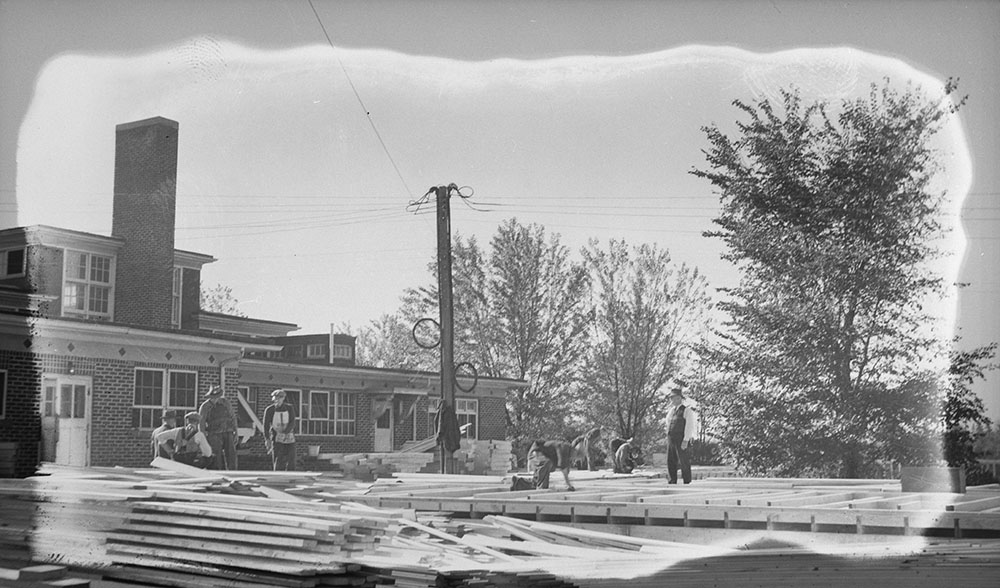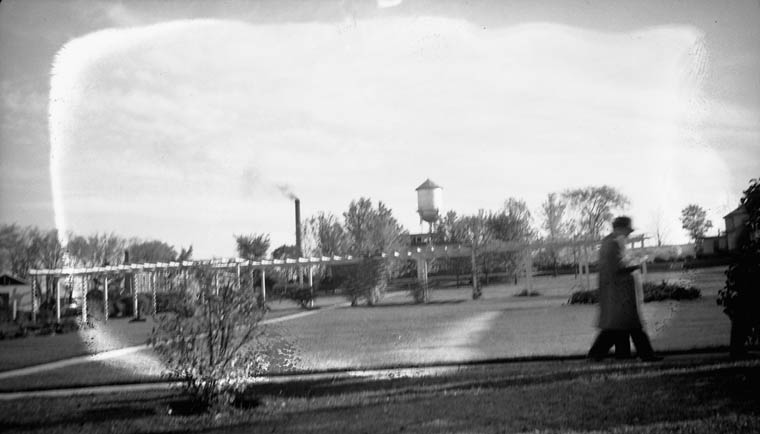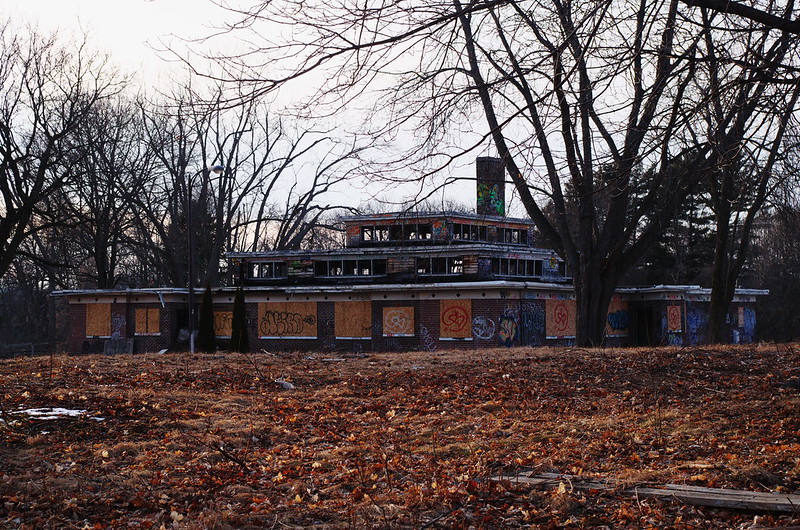POW Camp 30 is an abandoned former school that served as a prisoner of war camp for German officers during the Second World War. The camp was located in Clarington, Ontario, just outside of Bowmanville.

School
In 1922, Bowmanville resident and businessman John H.H. Jury donated farmland to the province of Ontario for the construction of a reformatory school for boys. Additional land was purchased by the government, and a school opened on the site in 1925. It initially housed just 16 boys, though the cafeteria was built to accommodate 300. The school’s facilities were expanded in the 1930s and were also used by the local community for fairs, games and festivals. The buildings included an indoor pool, gymnasium, and hospital building, as well as dormitories and a cafeteria. (See also Prison Architecture.)
POW camp
From 1941 to 1945, the campus was transformed into a prisoner of war camp for German officers. Guard towers, a perimeter fence and barracks were built to transform the open environment of the school into a prison. At times it housed up to 800 prisoners, far more than the school’s original capacity.
Did you know?
During the Second World War, 34,000 German prisoners of war were held in Canada. The largest camps were in Medicine Hat and Lethbridge, Alberta, each of which held 12,500 prisoners.
The camp held many prominent German officers who had been captured, including three generals. Life for the prisoners was quite leisurely. Under the terms of the 1929 Geneva Convention Relative to the Treatment of Prisoners of War, officers were to be “treated with the regard due their rank and age.” Thus, they were not involved in manual labour projects, as were prisoners of war from the other ranks. Conditions at Camp 30 were also better than at internment camps set up for Japanese Canadian civilians and at other POW camps in Canada. (See Internment of Japanese Canadians.)
Prisoners at Camp 30 had access to an indoor swimming pool, sporting facilities, and farmland on which to grow food. The locals, who were subject to war rations, allegedly complained that the Germans ate better than they did. Prisoners were even allowed to take day trips outside the camp, for activities like shopping, cross-country skiing, and swimming in Lake Ontario. They gave their Ehrenwort, a German term referring to one’s word of honour, that they would return. They also staged plays, established an orchestra, bands and a choir, and worked on courses and professional certifications in the camp’s classrooms.
Escape from Camp 30
The camp did see several escape attempts, however. One of these centred around infamous U-boat captain Otto Kretschmer. Known as the “Tonnage King” for having sunk over 270,000 tonnes of shipping, Kretschmer’s motto was “one torpedo, one ship.” He communicated an escape plan in a coded letter to Germany, which was approved by U-boat fleet commander Karl Dönitz. Kretschmer arranged for a U-boat to collect him and three other officers at Pointe Maissonnette, on Chaleur Bay in New Brunswick. (See U-boat Operations in Canadian Waters.) More than 150 prisoners worked to build three tunnels to help the men escape the camp, in case one tunnel was discovered.
Canadian naval intelligence, however, had intercepted Kretschmer’s letters and decoded the messages. With the RCMP, they began planning their own operation. They hoped to allow the escape to occur and capture the prisoners and the U-boat at the rendezvous point. They monitored the tunnels and carefully examined incoming mail but allowed secret messages to pass through. At one point, RCMP intelligence dismantled a book found in a Red Cross parcel to find a map, currency and forged identity documents. They carefully re-bound the novel with the contraband inside, duplicating the cover they’d destroyed, and sent it to the camp.
Before this counter-operation could come to fruition, the prisoners’ plans were foiled. One tunnel collapsed from water seepage; the ceiling of the barracks caved in beneath the weight of displaced tunnel dirt from the second tunnel, which the prisoners had stored there; while the third tunnel collapsed when a prisoner walked above it. Though a U-boat did attempt to reach the rendezvous point, Canadian forces were unable to capture it.

The Battle of Bowmanville
In October 1942, British Prime Minister Winston Churchill ordered German prisoners to be shackled, including those held in Canada. This was a result of a tit-for-tat diplomatic spat between Germany and the Allies regarding the shackling of prisoners. The situation arose from the discovery of Allied orders to bind German POWs during the Dieppe Raid and retaliatory measures by German command. Prime Minister William Lyon Mackenzie King initially objected to this decision, which had been made without consulting Canada. Despite public outcry against the idea, which violated the Geneva Convention’s rules on reprisals against prisoners of war, King eventually conceded.
Attempts to shackle prisoners in Camp 30 led to a riot. Prisoners armed with hockey sticks, broom handles, bottles and bricks barricaded themselves inside several buildings, particularly the cafeteria. The guards tried to subdue the prisoners without the use of lethal force, but some buildings proved more difficult than others. In one conflict, a water hose was turned on the prisoners and an unpopular Canadian officer known for striking the prisoners was captured by the Germans.
Fresh troops were brought in to quell the protest. While their first attempts to take back the camp with baseball bats failed to cow the Germans, they succeeded when they threatened force with rifles and bayonets (although they’d been ordered not to actually use them). Some prisoners were moved from the camp, and others were shackled, though anecdotes suggest the guards may have loosened restraints or deliberately dropped keys within reach of the prisoners. In December 1942, Churchill revoked the order to shackle prisoners altogether.

After the War
After the war, the camp reverted to its original purpose as a reformatory school until 1979. A series of private schools operated on the site until the last institution vacated the premises in 2008. Since its abandonment, the site has become popular with urban explorers. The condition of the buildings has deteriorated, with graffiti covering the walls. (See Ghost towns in Canada.)
Camp 30 was declared a National Historic Site in 2013 and is the last intact POW camp in Canada. The municipality of Clarington and the Jury Lands Foundation, a nonprofit devoted to the site's conservation, have been working on plans to readapt the buildings for community use while preserving their historic character. However, estimated costs for restoration are high, and the buildings continue to deteriorate.

 Share on Facebook
Share on Facebook Share on X
Share on X Share by Email
Share by Email Share on Google Classroom
Share on Google Classroom






